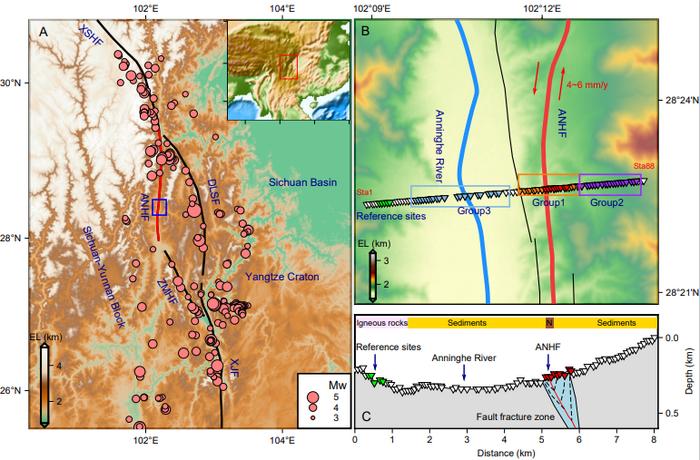The understanding of seismic activity and its correlation with natural phenomena such as tidal forces have taken a significant leap forward with recent research surrounding the Anninghe fault zone, situated on the southeastern margin of the Tibetan Plateau. The study, spearheaded by Professor Huajian Yao and his dedicated team at the University of Science and Technology of China, utilizes advanced seismic monitoring techniques to analyze variations in seismic velocities linked to tidal interactions with the earth’s crust. This research delves deep into the mechanics of how minute fluctuations in seismic activity can reveal critical insights about fault lines and their behavior under natural stressors.
At the heart of the investigation lay a dense array of seismometers strategically positioned along the Anninghe fault zone. Utilizing seismic interferometry techniques on continuous ambient noise data, the research team has successfully monitored temporal variations in seismic velocity, providing a clearer picture of how these velocities shift over time. This innovative approach contrasts with traditional methods, as it sheds light on the hidden dynamics within the fault zone that were previously obscured by limited data. The deployment of this dense network is not merely for data collection but is to essentially listen to the earth’s whispers, capturing vibrations that hint at the intricate workings of geological systems.
The results of the study are illuminating. The researchers have observed pronounced periodic patterns in seismic velocity changes, characterized by daily, semi-daily, and monthly fluctuations. These changes reveal the fault zone’s sensitivity to tidal forces, suggesting that the earth’s gravitational pulls—exerted primarily by the moon and the sun—play a significant role in influencing seismic activities. These findings underscore the intersection of geology and astronomy, where celestial dynamics directly affect terrestrial movements.
Moreover, the analysis presented in the study further illustrates the high sensitivity of the fault fracture zone to tidal forces. The researchers employed a spectral ratio method derived from teleseismic waveforms to evaluate the characteristics of the fault zone. Remarkably, they discovered that the fault fracture zone exhibited elevated spectral ratio values compared to surrounding areas, indicating a greater degree of subsurface fracturing. This revelation is significant as it demonstrates how localization of geological weaknesses can result in amplified seismic responses under tidal stress.
The research draws essential connections between theoretical tidal strain models and observed seismic data. By comparing empirical findings with these models, the researchers have identified strong correlations across the timescales studied. This connection suggests that not only are tidal forces critical in the deformation of the crust, but they actively modulate seismic activity and fault dynamics. It raises compelling questions about the predictability of earthquakes, significantly in regions where such correlations can be reliably established.
The sensitive nature of the fault fracture zone makes it particularly vulnerable to external influences such as tidal forces. The mechanics involved are fascinating; as tidal forces affect seismic velocity by causing minute fractures within the earth to open and close. When fractures open, seismic velocity diminishes, whereas closing fractures result in increased velocity. This continuous interaction emphasizes the delicate balance the earth maintains under varying gravitational pressures—a dance of interaction that results in shifts observable through seismic monitoring.
What is particularly profound about this study is its implication for future research methodologies in seismology and earthquake prediction. Utilizing an ambient noise-based approach to monitor fault systems not only uncovers patterns previously hidden but also enhances our understanding of fault dynamics. This understanding plays a crucial role in assessing earthquake nucleation processes and seismic hazards. Knowing how tidal forces impact seismic behavior opens pathways for advanced predictive models, which are essential for mitigating risks associated with earthquakes.
Tidal influences on seismic velocity variations also prompt discussions surrounding preparedness strategies in geologically volatile regions. The insights provided by this research can be transformative, aiding in the development of real-time monitoring systems that could alert populations to impending seismic events triggered by tidal stresses. Such advances would not only improve public safety measures but could lead to the establishment of new standards in urban planning and infrastructure resilience in earthquake-prone areas.
Furthermore, the findings emphasize the interplay between natural phenomena and geological processes. They remind us that the earth is a dynamic system where celestial events can induce measurable changes in the subsurface. This interconnectedness requires an interdisciplinary approach to both scientific inquiry and policy implementation, bringing together geologists, seismologists, environmental scientists, and urban planners in a collaborative effort to understand and respond to the forces that shape our planet.
In conclusion, the groundbreaking study on the Anninghe fault zone meticulously illustrates the intricate relationships between tidal forces and seismic activity. It serves as a powerful reminder of our planet’s complexity and the ongoing need for advanced research methodologies to decipher its secrets. As our tools for understanding the earth evolve, so too will our ability to anticipate and respond to the natural events that significantly impact human existence. The knowledge gleaned from this work offers an optimistic glimpse into a future where science and technology combine to protect communities and enhance our resilience against natural disasters.
Subject of Research: Tidal influences on seismic velocity variations in the Anninghe fault zone
Article Title: Pronounced temporal velocity variations within the fault fracture zone in response to Earth tide modes
News Publication Date: October 2023
Web References: http://dx.doi.org/10.1093/nsr/nwaf023
References: Not applicable
Image Credits: ©Science China Press
Keywords
Tectonic activity, Anninghe fault zone, seismic monitoring, tidal forces, seismic velocity variations, fault dynamics, earthquake prediction, ambient noise, subsurface fracturing.




